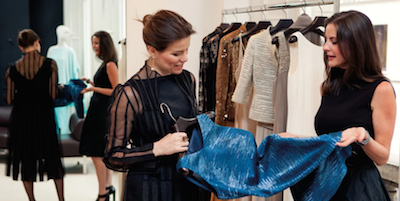Retailers often overestimate what is necessary to create a positive customer experience and drive loyalty, aiming for a deeper emotional connection than consumers expect, according to a new report from InMoment.
Brands believe that consumers feel stronger emotions when having a positive shopping experience, and they also underestimate the severity of consumers’ feelings when they are dissatisfied. When it comes to loyalty, consumers are most apt to return to brands that deliver “satisfaction,” with that emotion outranking all others.
"Despite the move toward a more customer-centric view, many brands still construct their 'promise' with little or no input from customers, and then don't revisit the promise for years and even decades over which the customer and the marketplace may have evolved," said Dr. Paul Warner, vice president, consumer and employee insights at InMoment.
"In this age of the customer, both co-creation and co-evolution of brand promise, and how it's executed, is essential," he said. "It's not that brands need to change their promise with every new customer trend. However, they must ensure the promise is relevant, and tied to what customers value most -- what makes brands truly unique and valuable in the eyes of the customer.
"This study revealed that when promise, expectation and delivery are aligned, customers are both satisfied and loyal. Once consistent delivery of that basic promise is achieved, then brands can identify 'delight' moments that are truly meaningful to customers, and inspire them beyond loyalty, to advocacy."
For its “2017 InMoment CX Trends Report: The Power of Emotion and Personalization,” InMoment polled 20,000 consumers and 10,000 brands across 12 countries, including Australia, Canada, Denmark, Finland, France, Germany, New Zealand, Norway, Spain, Sweden, the United Kingdom and the United States.
Emotional experience
InMoment’s survey asked consumers to share what they feel when having a positive customer experience. “Satisfied” came in first with 38 percent, followed by “safe/reassured” at 14 percent and “important” with 12 percent.
Qualitative statements from respondents show that for consumers to walk away from a retail experience with a positive outlook, brands need only deliver on their promise, whether that is getting them the product they came in for or honoring advertisements without a hassle.

Image courtesy of Westfield London
When asked the same question, brands also ranked “satisfied” first, but it was mentioned by only about a quarter of respondents. They also differed in placing “part of something special” in third, with 14 percent to consumers’ 7 percent.
When it comes to loyalty, there is a similar split, with brands underestimating satisfactions’ role in creating a return customer and weighing a sense of belonging too heavily.
InMoment advises against reaching for lofty emotional goals, which may in turn pull a retailer’s focus away from simply delivering.
Looking at negative experiences, consumers say they most often feel “disappointed,” “frustrated” and “disrespected” when things do not go right. These emotions vary slightly from country to country, with North Americans more apt to be frustrated and Europeans generally angrier than those elsewhere.
While brands anticipate consumers’ feelings of displeasure to a degree, they underestimate how intense shoppers’ emotions can be. Retailers also ranked disappointment first, but they gave that and other less severe emotions such as “unsure” and “resigned” more points than consumers did.
On the other hand, they mentioned “angry” and “disrespected” far less than consumers.

Shoppers are easier to please than retailers believe; image source McArthurGlen Designer Outlets
Consumer expectations are lower than brands believe, but when retailers do not deliver, the result is an angry customer who is apt not to return.
"First and foremost, deliver on [consumer's] expectations, and do so consistently," Dr. Warner said. "The exercise of aligning these elements will help brands understand the differentiators their customers value and thus where to focus special effort in elevating stand-out moments.
"Another factor the study explored was the area of personalization," he said. "Luxury brands have historically done a fairly good job at personalizing the purchase experience, which isn't true for most sectors.
"In order to provide an elevated experience that drives loyalty and advocacy, brands must personalize other moments -- specifically advertising and marketing messages, and support encounters. In addition, luxury brands can do more to understand the expectations of new customers or emerging customer segments and deliver a differentiated experience that will impact lifetime brand-loyalty for them."
Personalized touch
One of the ways brands can provide effective service to an individual consumer is through personalization. Marketers and customers agree that a tailored approach is most necessary in support, with the purchase path and advertising coming in second and third.
In support, consumers want the representative they are speaking with to know about them and their history, facilitating the conversation and service.

Image courtesy of Saks Fifth Avenue
Personalization can also impact a consumers' purchasing behavior. A previous survey conducted by InMoment found that even with the rise of digital channels, frontline sales staff are far from obsolete.
The bricks-and-mortar shopping experience no longer exists in a vacuum, with consumers arriving at a store armed with information from research conducted before or even during their trip. However, while shoppers spend about twice as much in-store when they navigate to a brand’s Web site while shopping, their expenditures grow to four times more if they interact with both an associate and the brand’s Web site while in-store (see story).
When it comes to personalization, retailers’ ideas of their own capabilities are often inflated when compared to consumers’ assessments.
A TimeTrade report found that while 69 percent of retailers say they are delivering an individualized shopping experience to customers all of the time, only 26 percent of consumers agree that the retailers are successfully providing a consistent experience across all channels. This divide shows definite room for improvement among retailers as they seek to provide a positive, personalized customer experience (see story).
"Due to the nature of the luxury market, brands in this sector have a particularly high bar when it comes to personalization," Dr. Warner said.
"In order to scale the personalized luxury experience, brands must invest in the right technology, the right talent and the right culture," he said. "This is the only way to consistently create and deliver authentic experiences that add deep value at scale.
"Moreover, understanding the differences and similarities between customer segments and capitalizing on the similarities, will help luxury brands scale those customer experience factors that have broad, positive impact."
{"ct":"oG6\/qnoKSbuOfKoTzREpUjz5C7VuVacFsUWTkMEV6VLioli3gPloaVHS\/BttlM\/muKQKLS5\/Bej+CxwcBvXs81t8lfPqb5aDo0zp85crq7c1rCkkM2vtYVrBY+8hN0YVRmmijR7CtjuI\/tLSLMEqdZxncqelznp4LfGHuJwoTKeqGT0NpH1ARGWbWOpqD9zwG3x5VrmvynekWynV4GXzmZLzHWY9g2K6lNaSXQTL+rYF4ptLWsgRKvWxpEU5bI8\/rcc8o3nduqykEY418AGVMKm3h0p1uph2W0MWsyi11MOmmDSXnAMe7DgN4ASq6EK1Sfp+6CYVrcgO1SJJVRBkYxA4\/mvvQT7fhv+hdWGUjGSInsvxzZIXoHnDWI5iPHLZ7Xl+MHHsbI1rApS8e+qkU7+2t\/48P3m1zCjXgopRXQjcLfoYoR41Y0ASWTh7yUUQS3IqRXxXEvuUSu8xJVCNQJzSrQDSi4EkpBZjvHuwu7M756ImSITFDQLax7mV5YeOCVzaR\/\/0oWQkW51vhf4x9b\/eeGlT1vDH7MerS+gJ6pP7vCigg7M9xYhy2+xpQNYBZY3yw9oDW7amedweSwktfcWxd7J5DcVbeBIuxZ\/u4re6L\/eOLJkaL46iyjOKYLymcvzYmXz0Fqc+tFds2yqGsRNGdGK+iY0N7O8TDJKMo7ptPcn5vxDyTDrMMjmVnqgMokpqmP8jMmjS9x6m5SmjrNdIAk9s58MzCbmPoqB\/N0WH5k+aBtxRJPThYNpcTy9WoMEIZlOuEP71PPWeq\/gWat4jjhxszuvNZv0A654M3+fbFayRNGekWwfJ2QbSUD52mKOsCwDRAkYH21jQLpAN5kVeaBDttuzFI0aH54UvKSCNTas\/HcUUvKwz2KD5LgrSvdN9aJ0\/R8kn9qfZZGmiWVmgvdch3RHIcDU2S1+Sfy03DY7NoBlegGqZ7zHcx2M5OWvK8Ex2a5GQFlIgAs5oBxRUrND1As25oDBF+enMvWCO+7A70ez+DRoTZrSxopw4viO+\/po24PdndEK\/CIJ\/zYu\/d8+5E19n9+5\/05K9bU8dnWVgknBirFagNkhbfK3P6PomvEPbpSHAP6qDVsUcdxFaXcOCVy6OLOglkvFyWwvhnjSfHNJ9NA3QmHx3fxtPZckFbD0XlT82yxIetFVq6qe5s0imdo9WCovBmOHntMBRg2qNpQ66Qit+\/eb9tzDw+KtwS1ss8a3cuSEN2zf7IvTxN7jpVqWUzxwYm\/G+InQ9YW37RpbY949qq2TIy2NqXUwhsce\/lkEP1Om703BgqjO92gxfyimqWI1CjQoZI4\/nDlaPPWgH3jUlycvuPOCzboTA3qb7702tpk1\/Tui3YWhflAPxZTDGEcXAiaZsiqI\/lnyWbbv9\/G8eNdpEKfEY3IaLI5fCX8ja3Gpi8vyEtgA4qdru7YKF4of3xfzQby9hcmlFk\/7YSVvO5BCIM+0voP8uU0iE7k5VWNO3ciKJ1weHGLD6Lhdt5UzjwhAnPLvZlP9uaRfg61587gva8NMUXtFBlPtcLSt8h\/7pSffEdn0+Ax+Y+E2AE6bLZA7BdoGPmkl3eHiB4JGfL56eU\/twFDXd0T65LuaXcAB8I\/f2v4vASaWRyRKGsLUNeioc\/XPBBK0aAq\/+K2+95gDa66oEG+WuafF6TpAyNZyvK8WtXgAcdAebhj8X5uVgk6T1rB4KiTOMHjOC5FBR2xEf9m9mu\/esww36Vvc0GSFCl49Tv9mtvde5be40ksx68prPCCVpI55LeMWENnHv5SItzGm\/fZymnWP7BsMaNngfidB41SwgMehzzdGAzvWvYjAL95asohCLC4qGPEODlYyIl2ip8USVAuO5cSN93KRMF7+Ao5GM\/bU05hJmUPBtKiqFQRdRDr4dfooo3fTJ1LG5S3Y99ydCFMO20t2JA6SdjO52Y6IiUSVGfeuup2Ak23h\/mjBAdnpsUGnswVYkYiyzWdBciOlVEvoC01ji7kRU9uweGdeSMBviKBg9lNT2Jpdoqe+5C0Mw1+myBc6Ilg+xMWOT0QdBAi6nSlO0WAZ5prbzUGzKEc+L+XRaN\/J+EBy6DBJHVjwBJRVVvFPFASlcDEnKF2toMjqSq\/Qcn6UYO4tMkTd7Jzw7cn\/lEwguFjelnfbkEyaRgChG5jd\/jiymsqun2eB4xVitO\/l+nrEJ0nugepUhzMoUAVfRqlChI+6mE2gt+e4VltvYyvp6GXt3geHsmfInICK9r6tVO4aq3LxesjazDPwq4c676Ir3bmDyfk\/rXN6hGXLOBHsXX\/CTHn0hEYsF4oCLH+rGfMGuUMm5uJutoyWlQ187bmWmEGVB9xE8ma5VXrP4qymgdN9pFdvkrEYCyfpdA6cgQw11o3Qs3RnI5L0ID6gErqbu7b6006VJSDCqwiN4K\/4pD5SofjQzNUJJVdN0Zf8ILMf6h+WyCbjd+KaMzvqocpB1bD++bTEw+5g1FCVmr4kaCI6aGqUbwMj+dwHqFlghzSrVLSAjxIJ8Opg9gx+9Yb8Y77JxA\/dIovPIxct3i2Z2qG+FNjtAwCEOTunuUaxFONCzpiOVF7K0iSAC8WecEutYuLrXIcZiHbaxd+smkm5UC0knOg+aUy3dcuMfRlq9vRlugXdI+oTGnPXvGgYNM4Fy\/W0rbSVTwr5Od1jr2LzlVx+y5YP9BOSgT4V5YjJFA2lHIwNryyhITzIVfP8zedWRRsXAtmt6Iokgpmt4S+JQcZ1R2UJdtQ1VUN08WSs39mvVjz1fGyQNdbiGiZuRDZIxV3Sj8f5Z9QUxdW9C+F7vYvrvGBV+EGd+3si4C1dvKsjpukF8Dx0Xo+hzcdKri75jANT1IZQK7ZzAsy3eAYmikQK+5d+IsWKIZGGMP\/ZFqR8x1wnZhClJS0+VY+m2tiIW8TIo6qzdb8sJZ0wNSvbfH8n2+CvR5Ko3JTiFJltSwTHHdGQRFmPaVFZbcOTUruobcZgcOlAfERkMr+EHSWnBrc3E7xPt\/1xxZ3TpZcnEOdH83kvpd5JuJFK\/v2Uflr2pXCKQtFXf2VKIa55k8IruVYhJhJyoOZX41cAa1eDy53xSKiLt3bt+q9GibDX0zdY6ZKlbgsXs1DboYGGTdzHJRAosxNXBIjhTahnQJj+ghtZ6fvgBdtJWPxAIaKE1B\/AxkMoQmhbb6+0yHz5zlmko76ErQW9CKNYPfBOJgtt39IENbVm9G2bqYrY7iwbecquGoslt6at\/cvB70xxUxhvR8FOKXJSyr\/lO\/0foRtzbJefMuq3lPANI2EjDVpfCQ9OJUQNYMgy\/kQdgx7ahwjVms2z50WJ44CEw1AB9jC8WWfEVOUG\/CH+kArwviXS3TMDekbJ1pEfAGZ6PLOcMOavILx6XpTYoGEGF83CJEdNUATtpJCcVdOfiu74+T0JhJwhd6CmBuouhSa7S2+gJYtNR9XUObzvpoeYs0NxQLl73sv4wiSaNZYzjAoUK1Z\/tUWJLKPTrGE2TbDaUgC+tvDSlL8u+4hAImHM4afdQUph0R1fgT\/5Mz5pUaCmv4ZIuezgcYHoAmnMhNiB6ncImp5p+t4Ytu5tHJq16wf\/bVTh+h\/aN3wZ7MSNH3MMK9F5xsze62E6tmfgB1TqVeh\/tplr4AawKPJhfT5Gpbw+xtrNZzhsFoJ4TPjEJrTRZVsZwiX8sJKVBmhsy87QjsyrthX6uMN1KpxJwOZ+uxj1jcBc0gDi+lo\/8W5pdYIqIvH7d17TwtB\/Wicpgp7ZW26x3utYQc7EbcjKjQ4+D5BowGdkET6oBbS\/DroQBFByYvUh5D8Qrli0l+ZGSb9GOTa4hMI49y1gxkR9fuGUOtzVp5kmVmqkbGjXj+C7RW1aSV11JcsfS687ifzW38JocpRuhElQXMFcAmXxhCPAVnT9y+OAStwETKQCS9xbN3Ct5CUbr\/w0aAcEpFrF7xuIDwh3hcDYC2PG4O6A84d8c3TqLDf9why6+QCcoHo1uVwt1W1NpPUwUDFP2yot6IaOOXiGyEpaqN5WqAFXHbMfng1APtZMW780I2hwaHb\/vJuEMfNCIgfycLg9687Csk17xH92jH6LstoXyPIXfNjnyWLeRBSLLYe\/C4vOh83YoYwSRDb\/XOo3lmHKrOUjDpLw+X1OBHy595MoQK3zGnEpXhtnv7P\/cEskhw9CE4GaTvOwFsOYdFmwATbMHgEskVt00JxHprk9Iv31aR\/ir3YI\/W+mN2xrd4lg0xTTwJ2Hq3fP+XuxGeQeUR+gb3P84aXWHnFX2YLQs3azTe0xFQ\/xnKZnuZfBVsLSe0IV59E6NnTwaxio9vzUa0Du2KnytTRDjbK3YNNWXf1Xs2XUHKRdWq8QYIkTPFIn4xR5Xx5WA9pKFUMqp9lUgAdZ5nJ49Xa2CG3Bt9f+aDqMsjlLTjKVph1psn0OT+BMKxt8DI9eurnk15fZhdOsVtEjBtI+OMEhtxy6+YgtZeemSRaugXt6RCtLRjGrxmzz\/IOk9CV\/eI7h9KIpM1VpT00BN7HzTovrxEU8iwl5GZvDSdh9K+o4X7HLyBZN+jCmy0HeQ9px+U6BRGrwxa1SkwTqyRiNVT4HLWKSQ+xOsFukbeaH1G1l7m9k\/yyImaFcKvE5Ve0mPY5+Am6\/4f1ep9WHLjut+PI097kVwqZBJcOkc\/r28\/b6aHMumlw\/izIYl5inWuLl6TAgiqWqMjY0MZTEF76J2\/28SsRqCBk\/Ix2f56FaXdPjqqw\/D2hIBI59iPyLUkGYTqWBar1oVzV2ZettFWKtKyj1xFawx1xddFpL4p3ZJoDcQlwdKT+4dWfBdeBQ9RcWfthyN23fRdxARl\/nmTZpmVn8qOkdhUlWmm9QOkM6jh\/46F97xArm4cI7CfP5s3w+0KTUf341XPrPSzDQgHxC9ZgiPKJspK\/2FP4WkAUNhZFWn0pASbp3hK9VGOEQhUbU9w8aYk4fB8sPJBDtZtkyjPVZOsRy4XCc2IqTHz7vCrDARfIx7y2rdpWyqmTAe3wvc8XG4htmtl8JG6w2dK4xlvoL2xr6F0C8OFk+EsbKU\/8w25HNjBbuyi33ZLVvTqwbWSRcnmW4RIUzWhvdzHTr8TEmifFJJrfkfQoc9plAVxJOVmRYQe3kiiy+OsJUoF38i4N5MtsOFiPxFJxJJfKzw1aRsNqRsiP0nOW7y7F7046I8phRMYRLocSjwRAu1SXvY+Td3qQFpi9b1G+6HeqiMF8kiaCLyQ9qOgHl51QEvCBZdsyENI9+9zFY6f7n3Kqs\/IOQG6snHtEQM224e2aOUsGZffWMzmLyyj3zK7yShSL4PMY+zlZWuEisxtyqoAYb6NQ9gkZgaIueI9pViXZmX668lsxVGMUfmsXc1bOby0oqBItLqU0NW6U+s4GgI2aJykg9pHyZmhDUs81htB6z+D2\/FSl0YWhkaRktmEBogLacNbCw33oBspgk6HShQ+Wd3\/7veBCeBs1DYcVyqETURC27hyb9rMJwmY6T93cvjOgxpx2vLLQTQii3hGJGZXuz1QlT2qnvjKF1NmUMJq1tY3LGdNhftObUb6F\/MVj4g2J+9c\/Yx\/TeY\/hxYdpIMoWNTx838cWNmAoMtNo\/YPMqUyw\/bS9vDbxrVsZLzGn5ouAkdeldC0w3\/aCk8zXeIITvgLLskW3gC2xbOwBjMblP7M+D13BKX8fiyrhpH8TW5dx44ihLownhtksnfHD4moemTHSpajAMJGcm3G63uqs28Qjpl5Exz9nx7cwONvTxQCWBrPvnGxh7UebpI5srZ6l8pBl7jigrPlHL+6SRLUGYZSaMZV6hlwZz2DShfjtell3MrKXaSsb\/npWSwah35jondEXsUpV1SPr2ndNogidPeyWOyEth6EzsVGeycD7j+9iwHX+Tfp7He45pJPgLBeks8aprCAG82LA2b6Q19G1PwsQYLvNpHVBvZuxryYELFI2MX8YOrtE+RxzkPAcd3ZavWmZRHofgamNYCKVomY6iE6qiguLW8DgDodj3OHij9pfZ2Y1mgSVMw7RW9vV4wuCgKFVfGmTxX5W1JeB9y9aZ2\/D90IrUXBDxKMp9AbNfFt8bx1hlmyjv2pKdG40RdsUZOMS2slanZD76yZKNU2ZNRg+Umu\/8qiuju+1R1JRbSUoUAdxI96HPxTdpn8hgfrwY738sJ7aoeCYgGvxjUdyxx\/9mty2WwjwArx1XZncKfRLuMD3+UvwvNkZFp+IpfMclGAAbPd+sTvsoE0NislUIdLawqZihSLMI8NUq8DfIuyDjfjWRW3pA6AbDZbG1SB7wyBy9nBVYsVxhnvHtieFCvX+WpcfLHbQoHsUzHIs7GEUpN9oFIi\/pSDDdV24dchnemciz1pEKYsA0WyafYlILSxG+teZC8RarEhNkRHXlUWIWdmsZDiInwq0V3k6lBTWflzpF65HCk6aypKibhdzNINEnhlZ11doje7JJnyr2t9BukSMY8yPu8ksoreAjup2D6HJXnD00YG0lYen7MJDebkDmwbBx88i+LLFXXwdOQvYHgbhkoUelDiUOnJbnNdGMKUPBcLGaVC4Wuz2DcB5D3wkZkvCGk\/jj63ITPqkiOFd\/+9DAuCJlPp7X8HEGOQfVzj\/EzY1S+pAk2wRl8XIc6S9mzMDLVIKrd4qWaTh\/8qeTIR9embkaGsxjGTdbXIMtaIxGctpQnlJRWFVm\/ZGwqz+KYTOaaxH6WLXxExhi2iXaVv\/5Xbi4WoIgLTFb3yi44CVLD6zy6q2TysJbKPi6tcHJ0+ZvGlFeMVOct99AN9S0WrYXgNAHCfXetuMwcIZ4jtO6Lzndu5ECke0q2wRtiqN\/6ybA\/UtgaWipW1G\/LdV2zdYedaUIP23i4XwzZhUTBasXhEm2WrYLSZ+7xRmzSr1G3g8OPnZVY5idIvWWmPDFpLuULAqCiM4sVtbLoW66Aw2FT8AkDjF1kUBAgUupkdEWBuvZZ8A\/pP6cyg\/WiaNHYAX8IeL5CfFvrc0GpJ5erjf5mhREfhII7e\/vds1EZPu+Dkavf+kxmPaaXJe000E1ptb35rcJ0980jphEahxNfJF0jbMrjbLPU8CuPaSxWFClKpwj9zk1vImkHBiXVrTMweYfm21RDzY\/wwCtjVo9zB5K6d6KPuEogVYRwQtb+u6\/OoaY4C\/L0Lap09UsioRpcc8UH7zz\/XuZP03QDjQRnPRNeciAQ5pUqbiZzFH5XJD0eVNy1a+G3nDpyfJBOiiI160O5rjbJ\/AY63+bWNQ0g\/xpeWxrd7i\/Vw73fwgE\/DCczEd2ZkOsrrusdd6ZRfNjoi5C0BBJ52T+C0t7a7ma14aYMalBIpUdigZwKSdKk560Tg43HTZTJYTGppaIMY3B284g8zBgR8idB2oWjgu4LAgFCQTdJ6HBFOgeE\/OW5sklmr8dfPWmerUEjMU3Znl4R8+8MPSa2+xoKa+dSAsSI+hy4+qT1a1d8JdQpfx7zO68S77brGoLX6xeknJT14hR1YtO9laiYfMPb+uZe9SiLdjSY\/UoD4CwzBRtJs3bfuaVk9UiR4TDem8jsivPLOhLWd+iQIqAkEzPZhc827IkJiK5AjN46L0Tw7iPDzRO+p4696MYl6uy7g5lVd50Ro6EpxmIH6l2EXqT+YflnTcRS51ahqRsVwLdbHOp8BqoHJcTuBN3MLZyyN1k0JDR5F\/Ozmkow2J13zZ1t2+9bb4p0ANHwfx07mghlgjo1HZ6OEEt0Ysa0WPJ3Q2tbxPNTPoX7WeJYPBTiTrOg2a\/Kvb905SpqAWJuxIGm0X8K8iS2eQe9oBvltFQL7IoSdOPACzeoj5Ully\/V\/sBkHvrZysTAjNlMvc6ZpCk0xUUiqkWtAUv4rm2YpzTeij6Iqvv\/JlLmdSDO3R92okt3EI9pEp18cg9H4eRPNN4TaDK7rjfjay+iNL6aUYMUH4tlsCiXThpUhFTVg6OVyg\/zACSfGQ3WIcgLuUa\/91wrPbb2GPegPGB29e9g0degCSkopUct1o2hqacZ5lSBVvf8+DBBPQUKegxzS5Lj3YXkLlCRdjHEzzS1wbM5gpUG8pMYNzS+Rq6D7cQD1TymC+0iHNYURxjO15vUGWoekqu9ze03+RjY5rZuT6bQ1ICWCku9Pu+uNI3YxsIvmvWlQdxtRQvz7tNYZGyksRXkzS5DcJXEhMG\/gGghdrXIy4B7KM+rTu4XTKnBk2za7cGQwUwnpUsXWoNXfW1WdlMAhV5yA23rc5\/rBG96Ctm430A2Ss5bdaNOei8lVTNjAspyCCmhUaglzxzf0se7bd6KsGbUNQdpB2lTz\/Jc51WPcR46dDciqbWdbIXLLCbLadbS0p79fPl+AYhUQZ5cTCuqfKwrvY\/P+CbCzQadj9r09rb\/4585t\/k45m3HkA7tQb3P9NXoZK+MiVI9SQdUJovFJ0wvhOc5UbjKXlNqswHCTqrPLuEpf6wcr58HDUZ7VW5StUm7jIYT5XUhQVn4rg8hS3i6iX6jpVuXiL0H\/Z6Io4v1FTCn+\/ghnLYQ0SJVKsp5yGD6Tq6gxlBA5qS4st5qQ1tRZKLDoS60OuX0J3v88HLeqShncT0SYoZpm5Ejh0Im+nIx44LhqgL6hLSTJUI++ZwKwJKKbv\/s2hJRRlj3rCdRL\/aZWX+yi2\/Qaqys9a44nLUTXzdYpIDD0P5jhUxbKkhyC1py6yHt9wFPx7R\/6keydlH3zX1L0HutDmc20V60OC3tJeosbsCBJw4l3wr90Dptch\/RvQCcAiJazzR9oiQHM01UyXx7W9v8+Esow5s+PAWy9m5B7n+ySKZL4NSelGWbk5NoC4K4JxGsFFj+z\/vwOa56AfAUFFH3uhwHKl\/DxgB2a+TUwzQmfbTFw1EauDteFg++YPALR1J\/7qUs1THDe0WSYw2MqeT4yQlfKixbS62ZS+LE5UVWX2CS2xeKWiMhSg6TltXwcH3UwG8nt9b0isIfY+w2cW7zG+U8q4jnmqBDBajHKGzNgUYKqJYRUtwb8deoc7JYxoSTGuOkWUVvsbO+JcthJ4r0xdRVXf0zqOSfST\/ohMc19ctCK3hvinFRtszAPJkrZUS4iGq3MNSR8L8EXXWYLChyi4zaLkooDyh3VSiSOQZZO\/EOiNSSU4+cQqTLZazyL8LJBujb2BNSuIl4Cvl\/fxe6jAmNeWPec76N4mJHG1FAPsKTDd6MBoPfFZWOPTtqylxckCZdO3zS4+n1sssvVe8q9Ssx5kLgNPKspHFcu2CSv2MvBeDir0GTAh78w4MKpykNNjxtnUAE17p1AktYxC5bGPfS9sTYpTBjfHwEt0iXTLbMMvtMlxvLCzzscJuiE2\/gNinU4UHo8FwpNh\/HGSQXYdBSIBMVFSVIRBHv8AKGHpvjmRtaPdakSJBdgx2RqGiT4y77kls3TFro4J0w8IJTGk8GibT7SoUMEbHsZTlBrBHnLlaZcN9\/dfqXypsj3SD5WCG4BjGT+IrbrlPLLDx9nMyb4iJPee332tkZ+R1cR6+1EGwDA3pwnoLf3w3rf7fFRlrQn9hKuu+GqseuaP3coMsPOwVwFFf3OBtJ9wgnFmn0gl8Qqk4rrLkRsqCscTv0sPdkduPmqu+i1nZabAR4EL9vdFRR35OtTGTPh3Yf0bdzw7Pgb5greZG8hQAMEMX7vHRz\/WuBVJSzLFTH7gJp\/uhHQ7tX7FajzJ95KMBl+RfJMriDITRW1P6J3IkFPgvddTk7dB5hik\/q88zxDWjnaXjrPuFnTS434NKVXd94PRMDXQIURy8JzbQ9d86hm+GY+MoeITeE+s11KoopSBrByJDhlYlk13wLirIQSQ4tL4RDmPJIlO5bK7pY+Ps2jTdMX\/jGgAnLFYjYXf\/h2CL7a5dclAcqtMHPL5k8jBbnY1xYiBguvuAL+mwty6ZdKYB1wY3C7feup2wzcrh+LLV28aGvCSfqVNdRN\/0KDwcjyLtvb7Osdi2MyYkbMd+wps5quXrVAUNw782yqkXW3+Ku8cknstzRI5FNcejoQMmmB4PS12yqWt0+n8vttBeHFHTaeQQbgXES33ba15FuY9kbrn7ik85fDM+7el1sdAylme11V0PqBl3Lmz0sIjbqMUWudi8VutSITPnJoxMxLBeEWAB6Hhu3qpK2SPa0bKyQEGEq7p1e\/g1w4YY7OZDCIYeITIqb1j7bsA6hGM1yJ4wodDRoiOrGDuf+kHWIq31Z0Jp6zRLftQD1AlNoKWqCD0KU6mUMEU03VWXukNQCHhwnpuXIDSGdrKHQIL9V7qpSPIi8396ueEf7wqdlBSSOn33yxfQaZmTNUHjkqxLWUrcpiOkLmV\/IXzxrYbbiqg0SVjOfASvvEyhzm8na7vwqsTFXfS8QfCN1ywMImmPqW9dIqHSejhunW9V0SeZw1+xS4bE\/7E50dk4cLBeMSUgzi0HBsiX2Yrqj2E8MkS8SvkcS1El+rTVnG03eTYCBzGYILJc3lkYLmxhnvzjJDEABkVu0F1HmqrIkBgU28ihekfLwYZFZTxypcNoLwmAGpOG6l4zcw0mesQQ7544FOaaK7a1wjT9EW4t7S37ZWKABygyYcIOTzYwyc+6Lqmr+S7ltyEbugdzp9U09GzLeRwu9oPv0NpadwIacqYI3cM4U4BY0SVmkWcBfSVIvC+1TLvNhySwGpeQ8P2Qlyo+ceBkV7PDizAR2IawQ9gQ8zIOHp06Km\/ZBXnePN9XjmhuyB66bdbgrWVaqlLDMSZ1i0S7NxDmzkSDBmHDwNK5OiToqgrji1J0DGaA0kFPJYdp7UQktsu+2ecML0aMGD0lzYxkD2sBvbuYGe9rpHfbC2VGbO4GSYaGVZtz\/lJvH5Es1VZrNKiiT2qgsQirMq8ocDQ+0UYIFIf5UU4WSAVpxgrupewJIIEsNivR1gBh7t1WDdQsFxVpq\/zjqMeSb8pwynWIIJRv3C3oB0cseq2vgD0OMsF0+\/IptXCdV\/aOo7+6xHw5VoVwF+DKYrRXp+muSPMo49WXMZOBd5D973lYVa\/ucaVrAF44u2YPSM\/evlNsiJomA\/SM7k6iRC2iQRF+8E+n1OZt0acijx3AI+RqnaQ04bf6yoIpmdnP\/gGGPs1\/g\/3GgZgCL0WFNdIU5rr9Yq9gXBN4fxnet7ybVEYAs\/GF5tiC8hhhn3Oa+ShKyqMjDDKrRA6SHZ46Jjcjo\/YjwSEsDQswuoBlfp1pIcVxlFmjiIlldbCWg+6S\/NKV9HWR+E1P9IvV0hbxjPqToRW+IMhN5hRHS11Lm1cVGWmfP3iYJwqzfJdR0gHwVSgCDuynHB28i\/MPm688kpniOsRTkWDKUp9Ts+VfCbaX985ZCCtu66z1hmW+tZj8V6R3OjkfkZFtCPyfNoBw8ZYmSk8X7fzO4di\/thHFqJSklKrLK1Dn2t3TxXyM9GAjnT0Be46uLloVyMlH\/+Eip\/iZB\/ryypYhfNrimb3cXV\/NR5JzmmyqJtpnOloul1175PWpxmVkK4DmkZYCT9eqIyVeTMD3tTxJvKLQ0bjjQvBWrhQH6yzIRAQWwE6FGMtsXboD49wTrhcJs9RdUBdaiZJ6qwBej4E88+Le03yN0s1QAZ4Nh90eLRtWZKMXPDm8\/hH0S5sTIJLhe8JoXRBKCW8M9wK9UXHrmVuh7y08pCsaZCJX+e5T3ZOU2syrlxt+S2M0zu+V\/zMk\/vMhNHPur4YXRVl2UfczOflHDkzq6k5qrhPBKFRXWqX7kQ2D8elvLNlgnhIDuZvGwsbKX53Odfnot00Pltelyww8O\/PjxZc7QYDMxUIDNgwwlDc2i31uOr+DGYv3i0A8dEKRRGdNUSnRrelfPDsDtlRmWQ1r7Pz5MkBpPh0WOrHZOHVH5Pyiqmhqgd8vlaCDXMt\/3n0875SJ0kVR7SJ\/BmKiNCfZtswjBBWDufkoWIJIX1+NdcIUF3LWH+UoOATd3QvitZaJdsiIVp4Vxm9q+FUlboRRiqlHLrrOLG54FUGpJ81q70QPMuBjyOqcXN07RDSm3pojEKVL5ruUtK7Yo+WNeAR8PWM8qn7se\/v5FLxuXFWDJ5+ZhNJno5zOC8uHMRVaDWK1Mafq4ycXb0MugVedcX+Ij13\/wwGJM2RoDwY7gT+h2EQWNy0Y7A+fxWN7tGhxLV5ItjbmSoB5nRKGFmNRGohQWcKhg96w4kH2O7Chw2kL5anpImveq+UAa2+3C2wFV7yTx1Q4V3nE3BeqQ7EJ98fB68MeEM\/DiYX7CKILUbYgDzYhYw4EUdK01EZyStxsU36393+Li1vkalfci\/WagyOW96SawqT8BL9ltreSad08n5z9P14bVEFcI0vsJEXy+uK\/Myo4mJy2nONU=","iv":"41f915f5da07cae23f7202414caa742c","s":"fc465670dab0a89f"}
